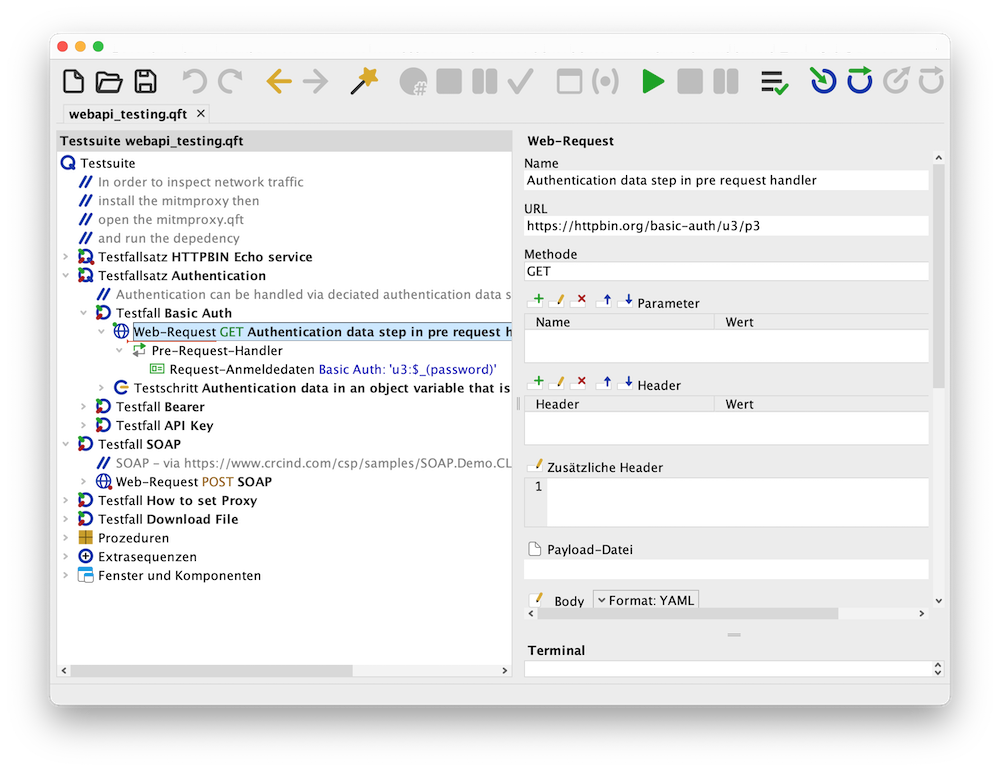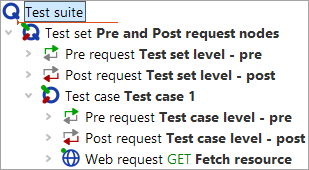With version 10 of QF‑Test, scheduled for release in the fourth quarter of 2025, we are expanding our proven test automation tool with completely redesigned tools for testing web interfaces. QF‑Test thus offers comprehensive capabilities not only for GUI test automation, but also for automated testing of web services.
Free QF-Test special webinar
In October 2025, we hosted a special webinar focused on testing web interfaces (web APIs) such as REST-, SOAP- and other web services. Watch the video now:
What is Web API Testing?
Web APIs (Application Programming Interfaces) are interfaces that enable the exchange of data and functions between different software components via the internet or a network. They form the basis of modern, distributed systems and are often provided as REST, SOAP or high-level API architectures such as GraphQL.
Web API testing refers to the verification and validation of such interfaces to ensure that they function reliably, correctly, securely and performantly – regardless of the user interface. This involves automatically sending HTTP requests, analysing responses and validating data formats such as JSON or XML.
Since web APIs are a central component of many applications, their error-free interaction is crucial for the stability and quality of digital products. Automated API testing helps to detect errors early on, make development more efficient, and lay the foundation for continuous integration and agile working methods.
Why is automated web API testing so important? – Benefits and advantages for your company
Automated web API testing plays a central role in quality assurance for modern, distributed software systems. APIs are the backbone of communication between applications, microservices and cloud services – their reliability and security have a direct impact on your entire product.
By using automated API testing, you benefit from numerous advantages:
- Early error detection: Errors are detected immediately after each code change and can therefore be quickly corrected during the development process.
- Efficiency and time savings: Automatic tests run without manual intervention, significantly speeding up feedback cycles and reducing testing effort.
- Repeatability and scalability: The same test scenarios can be run as often as required and at any time, even with a growing number of endpoints.
- Ensuring functionality: API tests reliably check whether interfaces are working as expected – regardless of front end or back end.
- Integration into CI/CD: Automated API tests are optimally integrated into continuous integration and continuous deployment, enabling continuous quality control.
- Increased security and compliance: Security checks can be specifically integrated to identify vulnerabilities at an early stage.
Automated API testing allows you to reliably ensure the quality of your APIs, minimise risks and lay the foundation for stable, powerful and future-proof software.
Challenges in testing web APIs
API testing can be challenging, especially in complex, modern software landscapes. Typical challenges include:
- Diversity of interfaces: REST, SOAP, GraphQL – every API works differently.
- Parameter and authentication management: APIs often require complex headers, tokens, OAuth mechanisms or API keys.
- Test data and formats: APIs process a wide variety of data structures such as JSON or XML, which must be processed correctly.
- Versioning and compatibility: APIs continue to evolve – tests must be able to respond flexibly to new versions.
- Performance and scalability: Not only must the function be correct, but load capacity and response time are also critical.
With QF-Test, you can overcome these challenges efficiently and reliably.
WebAPI – Your advantage with QF-Test
WebAPI is the name we give to the suite of functions in QF-Test that allow you to easily create powerful automated API tests.
Combination of web API tests and UI tests
High-level test automation and web API testing in one tool.
Support for all relevant protocols
REST, SOAP, GraphQL and other standards.
Visual test case creation
User-friendly interface and optional WebAPI scripting API for complex scenarios.
Parameterisation and test data management
Flexible working with variables, dynamic values and test data generators.
Seamless CI/CD integration
Connection to tools such as Jenkins, GitLab or Azure DevOps.
Detailed reports and analyses
Detect errors immediately, evaluate test coverage.
Secure testing
Support for SSL, authentication, encryption, and security checks.
Extensible test environment
Also ideal for complex, company-specific requirements.
Automatic Postman migration
Automatic conversion of Postman collections to QF-Test test suites
Immediate support
for downloads, uploads, error handling and retries.
Documentation and learning materials
Our manual, tutorial and sample suites explain all aspects of QF-Test in a clear and detailed manner.
Typical use cases
QF-Test allows you to test a wide variety of API scenarios flexibly and efficiently:
- Microservices architectures: Verify individual services and interfaces in a network.
- End-to-end testing: Test complete data transfers between front-end and back-end systems.
- Performance and load testing: Ensure the scalability and resilience of your APIs.
- Automated regression testing: Repeatable checks for new releases to rule out regressions.
- Security and penetration testing: Checks against the most important API security risks according to OWASP API Top 10.
- Functional testing
- UI testing
API testing with QF-Test brings transparency, efficiency and security to your interface landscape.
Methods of automated API testing
Automated API testing encompasses various types of tests that differ in their objectives and approaches. Depending on the application scenario, they ensure that interfaces function reliably, securely and efficiently:
Security tests
Identify and prevent typical attack patterns such as SQL injection, cross-site scripting (XSS) or unauthorised access to protected data.
Fault tolerance tests
Check how robust the API is in response to invalid inputs, network problems or error situations, and whether it processes the corresponding error messages correctly.
The targeted use of these methods gives you transparency and control over your interfaces, increases software quality and enables reliable, continuous further development of your applications.
How Web API testing works with QF-Test

Thanks to the visual user interface, successfully testing WebAPIs with QF-Test is not difficult.

Thanks to the visual user interface, successfully testing WebAPIs with QF-Test is not difficult.
Step-by-step instructions
- Create a ‘Web Request’ node: Enter the URL to be tested and configure the desired request type (e.g.
GET,POST,PUT).

- Set parameters and authentication: Configure headers, body, parameters, and expected response status code.
- Create “Request Credentials” node for authentication: If necessary, you can store authentication details such as API keys, BasicAuth or bearer tokens here.
- Create ‘Request Settings’ node for advanced configuration: For even more control over the execution of the request, you will find advanced options here, e.g. for cookies and proxies.
- Incorporate test data: Use dynamic variables and external data sources for realistic tests.
- Validate responses: Use the ‘Post Request Handler’ node to validate the server’s response via our intuitive WebAPI Scripting API.
![Assert.test(qw.response.headers["Content-Type"].contains("image/png"), "Checking the reponse header for a content type of an image")](/images/screenshots/qftest-webapi-scripting.png)
- Automate and integrate tests: Add your tests to existing CI/CD pipelines and receive detailed reports in HTML and XML format.
Interested in QF-Test?
Tell us about yourself and we will put you in touch with QF-Test experts who can tell you more about our product.
Case studies – these customers trust QF-Test
Automated UI testing is used in many areas – ideal for agile teams and continuous quality control:
The QF-Test WebAPI Testing Suite – Your Solution
QF-Test offers a modern, powerful toolset for automated web API testing – flexible, scalable and easy to use.
- QF-Test is a test automation tool that supports GUI testing as well as the automation and testing of web services and APIs.
- It enables both integration testing of APIs (e.g. REST and SOAP) and combination with UI testing to implement end-to-end scenarios.
- Thanks to its user-friendly interface and scripting capabilities, it is particularly suitable for implementing complex test scenarios.
Compared to other testing tools, QF-Test scores particularly well in terms of stability, ease of use and excellent support. This makes QF-Test the ideal choice for teams who want to implement professional test automation efficiently and sustainably.


